Description and Portraits
In my dissertation, titled “Framing Portraits in French 17th and 18th century novels”, I try to counter a general critical disengagement from the field of literary description, and go beyond the stereotyped image of description as a minor component of 18th century French novels. I do so by focusing on the study of literary portraits, a traditionally discarded genre and most often absorbed within the “character studies”. I offer a panoramic view of portraiture practices starting from a comparison between Madeleine de Scudéry’s portraits and Fénelon’s ekphrastic fragments, continuing with an analysis of Le Sage’s and Voltaire’s fictional portraits and conclude with libertine and Gothic portraits (Laclos, Sade, Potocki). Thanks to an approach that is both comparative (exploring multiple samples of literary portraits from different authors) and diachronic (observing literary portraits over a century), I was able to reach several conclusions. Firstly, 17th century practices and moral values set the pace for 18th century descriptive practices. Secondly, physical descriptions were provided only in so far as they offered inferences on a given character’s true morality and for this reason portraits consistently held a proleptic function, i.e., only characters who would eventually affect the hero’s destiny systematically received a portrait. It is only with libertine and Gothic novels that this practice changed: the authors broke from the traditional kalokagathia, ascribing to beautiful characters a good morality, and endowed their morally corrupt characters with alluring descriptions so as to confuse the reader and create a new sense of suspense.
